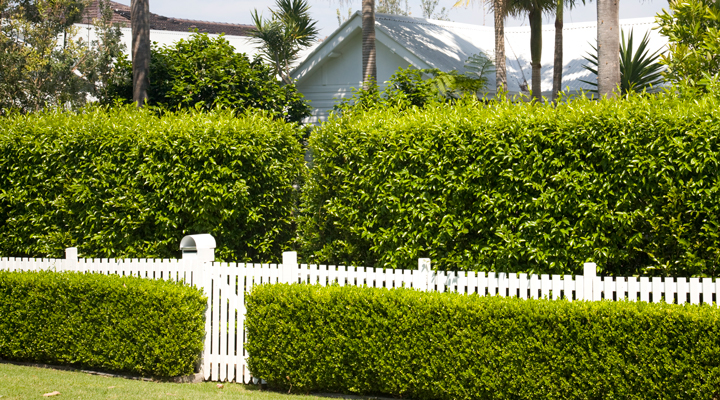5 best low-maintenance hedge plants and how to plant them
Hedges can be used to mark a boundary, edge a path or garden bed or screen out unwanted views. Hedging plants need to be evergreen (so they are green and leafy year round), suitable for clipping and robust. We've got all the know-how you need when it comes to selecting and planting low-maintenance hedge plants.
How to plant a hedge
To get the best from your hedge planting, prepare the soil ahead of planting by clearing out weeds and old roots and removing any stones. Break clumps in the soil. Dig in organic matter, such as compost or well-rotted manure.
Before planting, check the mature size of the selected plant. Allow room for it to grow in every direction and space the plants evenly in a straight line. Check your line is straight by setting up a stringline and use a tape measure or a measuring stick to evenly space plants. When spacing plants remember closer plantings create a faster hedge, while wider spacings mean the hedge will form more slowly, but the individual plants have more room to grow.
Water well at planting and regularly while the hedge develops and the plants become established. To make watering easier, consider setting up an irrigation system along the row of plants. Surround new plantings with a layer of organic mulch to help reduce weeds and keep the soil moist and cool. To encourage bushiness, lightly trim hedge plants as they grow.
Want more info on planting and maintaining your hedges? Click here.

Hedges can be low or high to provide coverage and privacy.
5 best low-maintenance hedge plants
Here are five of our favourite hedge plants to suit a wide range of conditions. If named varieties are available, select these for your hedge to ensure uniformity of growth and colour. Always buy some extra plants (or propagate some yourself) so replacements are available if any initial plantings fail. These spare plants can be grown elsewhere in the garden or in containers.
Gardenia (Gardenia augusta)
Gardenia makes a dense, evergreen flowering hedge in a warm climate. ‘Florida’, the common florist’s gardenia, can be clipped to around 50cm-1m high and can be planted about 30cm apart for hedging. For a taller hedge select one of the large-flowered forms such as ‘Magnifica’ or ‘Professor Pucci’ and space up to 50cm apart. Gardenia flowers are white and highly fragrant. Prune annually after flowering in late summer to avoid removing flower buds. Expect spot flowering over many months in warm conditions.
Click to shop Gardenia augusta

Gardenia 'Florida' makes a beautiful flowering hedge option.
Japanese box (Buxus microphylla japonica)
Japanese box is a fast-growing form of box that suits a warm temperate climate. It is grown for it glossy green leaves and dense growth. It can be kept clipped to around 1m high but will grow much higher if left unclipped. Space plants 60-90cm apart for hedging. This shrub tolerates sun or shade. Japanese box needs clipping several times a year during the growing season (spring to early autumn).
Click to shop Buxus microphylla japonica

Japanese box is a popular plant for low hedges.
Murraya (Murraya paniculata)
This shrub forms an evergreen hedge that can be maintained at around 2-3m tall. For a lower hedge (under 1m) select a dwarf variety such as 'Min a Min'. Murraya flowers in spring as temperatures warm, and after rain in summer and autumn with clusters of highly fragrant cream flowers. Pruning in spring may remove flowers, however Murraya can be pruned after flowering which also removes unwanted seeds. Space around 50cm-1m apart for hedging and keep well watered.
Click to shop Murraya paniculata

Murraya is a great choice for a flowering hedge.
Photinia (Photinia ‘Red Robin’)
All photinias are strong and robust evergreen hedging plants. They do well in temperate to cold climates and are drought tolerant once established. The benefit of the variety ‘Red Robin’ is that after pruning the hedge puts on an attractive show of red new growth. Plants grow 3-4m high and 2-3m wide but should set around 60cm-1m apart for hedging. Keep pruned as a 1.5-2m hedge.
Click to shop Photinia 'Red Robin'

Photinia 'Red Robin' is a popular hedging choice for a splash of colour.
Sweet viburnum (Viburnum odoratissimum)
Sweet viburnum is a popular plant for a large and robust hedge in warm temperate, coastal and subtropical climates. It has small, non-descript, fragrant flowers but is grown for its large glossy green leaves and rapid growth. There are many named varieties including ‘Dense Fence’ and ‘Emerald Lustre’. Plants grow 3-4m high and 2-3m wide but should set around 1m apart for hedging. Keep pruned as a 1.5-2m hedge – or higher for a screen.
Click to shop Viburnum odoratissimum

You'll smell the tiny flowers on a sweet viburnum hedge before you see them!

